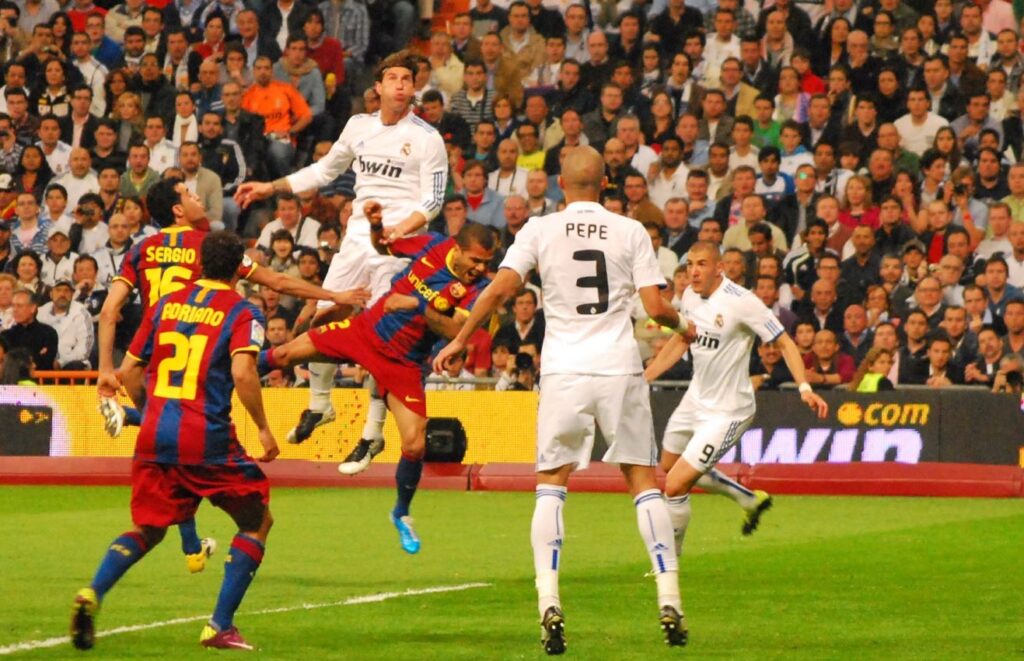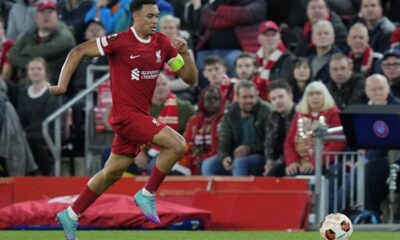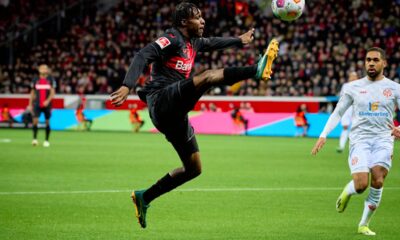Football
El Clásico, the biggest game in the world. Where did the hatred between Real Madrid and Barcelona originate?
El Clásico is without any doubt the biggest football match in the world. The clash between Real Madrid and Barcelona regularly attracts the largest number of spectators and stirs huge emotions. Even after the departure of Cristiano Ronaldo and Lionel Messi. But where was the hatred born?

El Clásico is without any doubt the biggest football match in the world. The clash between Real Madrid and Barcelona regularly attracts the largest number of spectators and stirs huge emotions. Even after the departure of Cristiano Ronaldo and Lionel Messi. But where was the hatred born?
The rivalry between Real Madrid and Barcelona goes far beyond sporting rivalry. Indeed, it is also reflected in the hatred between the cities of Madrid and Barcelona and between Spain and Catalonia in general.
The rivalry between the two entities also has political reasons. Although both clubs were founded at the turn of the 20th century, the hatred only began to be born around 1930.
Barcelona was founded in 1899, Real Madrid three years later in 1902. When the two teams first faced each other in 1902, the White Ballet had only been in existence for two months under the then name Sociedad Madrid FC.
Not surprisingly, Barcelona won 3-1 in their first ever encounter. The duel took place in the Copa del Rey, and given the fact that both teams were playing a regional competition, the Spanish Cup was the only opportunity for a clash.
La Liga was not born until 1929, and since then the teams have met much more frequently, which has helped the rivalry grow. The duels between Real and Barcelona used to be called ‘El Clásico’ only in the Spanish Cup, but nowadays every match is called that. To date, Real Madrid have won 99 matches, Barcelona 96. There have also been 52 draws.
The birth of hatred
The Spanish Civil War of 1936-1939 heralded the hatred between Real Madrid and Barcelona, and added even more political motives to the clashes. After the victory of the fascist party, General Franco came to power and used Real Madrid to demonstrate his power, banning the use of Catalan, for example.
Thus, while the White Ballet represented the fascist party in the matches because of General Franco, Barcelona represented the rebel group of Catalonia. And this is where the first problems began to arise.
It is almost safe to say that the greatest hatred between the two teams was born in the semi-final of the Copa del Generalísimo in 1943. In the first leg at Les Corts stadium in Catalonia, Barcelona won 3-0. Real’s players were grossly dissatisfied with all three goals, which they felt were incorrectly conceded by referee Fombona Fernández.
Newspapers all over Spain the next day said
Moreover, the home fans booed loudly at the Real Madrid players throughout the match, which was seen as a betrayal in the Spanish capital. Los Blancos goalkeeper Eduardo Teus, who also wrote for the daily AS, called the behaviour of the Barcelona fans “an attack on the Spanish national team”. Other media joined in and attacked Barcelona of organising the whole event against Real Madrid.
Real Madrid president Ramón Mendoza made his displeasure known in an official statement.
“It has come to our attention that fans were allowed to go to the El Club bar on La Victoria Street to receive whistles. Others were given whistles straight to their ticket,” he claimed of the “welcome” in Barcelona, with which he had until then had no downright hostile relations. But now a campaign of revenge has begun in Madrid.
So in the rematch, Barcelona players were intimidated, with fans even attacking the club bus on the way to the match. Blaugranas striker Mariano Gonzalvo let it be known that even before the match started, Barcelona’s penalty area was covered in coins.
The match eventually ended with a score of 11-1 to Real Madrid, but it was more of an embarrassment than a sporting feat. “Even if the Azulgranas had played badly, really badly, the score would never have been so astronomically high. But they didn’t actually play at all,” wrote journalist Juan Samaranch. “At one point we said to ourselves: ‘Go on, score as many goals as you want’,” Barcelona goalkeeper Luis Miró said years later.
The last surviving witness of the event, Fernando Argila, who was Barcelona’s substitute goalkeeper, summed it up as follows:
“There was no rivalry between Madrid and Barcelona. Until that day. The fans, in reaction to the first match, created a hostile atmosphere. Someone came into the booth, I think it was a policeman. He told us that nothing unpleasant could happen. His visit and the hostile atmosphere was behind the result. On that day, the rivalry between Real Madrid and Barcelona was born. Everything happened because of politics,” Argila said.
Alfredo Di Stéfano
Another reason is the (non) transfer of a footballer who later made a strong mark in Real Madrid’s history. Alfredo Di Stéfano is an absolute icon of the White Ballet, one of the best footballers in history, but also another reason for the hatred between Madrid and Barcelona.
Until 1950, Barcelona had the upper hand in their duels, but the arrival of a single player changed that. Argentine chic Alfredo Di Stéfano completely changed the course in favour of the White Ballet, but the footballer’s transfer was certainly not as graceful as his movements on the pitch.
When there was a strike in the Argentine league, Di Stéfano bounced to Colombia, where he played for Bogotá’s Los Millionarios. There he impressed Real Madrid and Barcelona so much that both clubs wanted to sign him immediately. And that’s what happened. Literally.
Due to the confusion of the transfer from River Plate to Millionarios, both clubs signed the Argentine, and both Real and Barcelona claimed the right to register Di Stéfano. FIFA had to get involved in the whole thing, which eventually decided that both clubs had the right to the player and had to loan him to each other. The humiliated Barcelona president was forced to resign by the club’s board of directors and the management cancelled Di Stéfano’s contract.
The Argentine footballer thus moved to Madrid, where he stirred up even more hatred in his first start against Barcelona. In fact, he scored two goals against the Catalan rivals, reminding the fans of the great failure of the club’s management.
Real Madrid won the European Champions Cup (the current Champions League) five times with Di Stéfano in the squad, and the Barracas native was a huge part of that success.
When he arrived at the Santiago Bernabéu, Real had a relatively ordinary team, which is why Spain was ruled by Barcelona for many years. Di Stéfano, however, almost single-handedly turned the tide of the rivalry and ended Barcelona’s dominance. Even given the fact that Barcelona fans could see this player in their stadium, the rivalry between Real and Barcelona was even more heated not only on the pitch.
Figo
Another footballer who has fuelled the hatred between Real Madrid and Barcelona is Portuguese midfielder Luís Figo.
When Florentino Pérez ran for club president in 2000, he promised to bring Barcelona vice-captain Figo to the Bernabéu if he won. Nobody believed Pérez could pull off this stunt, but the experienced businessman already had a contract in the bag.
In fact, he had signed a $2.4 million contract with Figo at Real Madrid if he won the presidential election. If the Portuguese wanted to break the deal, he would have to pay Perez $30 million. As long as Figo belonged to Barcelona, he denied everything and claimed that he would remain a Blaugranas player. Despite this, however, the Portuguese football icon was photographed wearing the white jersey in Madrid on June 24.
The only way Barcelona could have prevented Figo’s transfer was to shell out a $30 million fine. That would have meant paying the fifth largest transfer fee in football history… for signing his own player.
Barcelona president Joan Gaspart later said, “Figo’s move destroyed us.” On his return to Camp Nou, he was honoured with banners reading “Judas”, “Mercenary” and “Cheat”. In Catalonia, there is even a new nickname for the word traitor – Figo.
Fans threw bottles, cigarettes, oranges, even a couple of mobile phones at Figo, just anything they could get their hands on. In his third season in 2002, in a match at the Camp Nou, the hatred escalated to the highest level. Figo was pelted on the pitch with coins, a knife, a whisky bottle and even a pig’s head. Most often the objects flew from the sector where Boixos Nois is based, in front of which Figo had to play a corner kick.
The current El Clásico
Even in the present day, El Clásico is very heated, but few matches compare to the 2010- 2013 period when José Mourinho ruled the Real bench. Every match back then felt like a war, more often than beautiful football moments we saw scuffles, skirmishes and countless cards. Very often even red ones, rather on Real’s side.
José Mourinho versus Pep Guardiola, Cristiano Ronaldo versus Lionel Messi, Sergio Ramos versus Carlos Puyol. These matches were simply unique and the whole world watched them.
No match except the Champions League final has matched the viewership of El Clásico, which was heated for weeks in advance.
Among the most famous incidents is the moment when, during one altercation, José Mourinho took aim at Barcelona assistant Tito Villanova and poked him in the eye with his finger. Mourinho later apologised.
The hatred between the two teams and the fan camps was probably one of the greatest during this period, when the playing field looked more like a war zone. Still, these matches will never be forgotten.
Source: Wikipedia, Real Madrid, Barcelona












